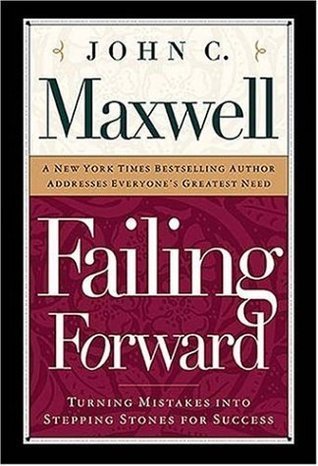Failing Forward Turning Mistakes into Stepping Stones for Success – John C. Maxwell
Le prix initial était : $14.99.$4.99Le prix actuel est : $4.99.
Description
Understanding Failing Forward
The concept of « failing forward » is centered around the idea that failures are not merely setbacks, but rather essential components of personal and professional growth. Rather than viewing mistakes as detrimental, individuals can harness them as opportunities for learning and development. This paradigm shift transforms the perception of failure from a negative event to a valuable experience, enabling one to build resilience and adapt more effectively to challenges.
Psychologically, the fear of failure can be paralyzing. This fear often stems from societal norms that equate success with perfection and immediate results. However, successful individuals frequently emphasize the significance of embracing failure as a stepping stone toward achievement. For instance, Thomas Edison famously stated, « I have not failed. I’ve just found 10,000 ways that won’t work. » This perspective underscores the notion that each failure serves as a lesson, propelling one further along the path of success.
The paradox of failure lies in its necessity; it is an integral aspect of the success journey. Each failure provides critical feedback, allowing individuals to refine their strategies and enhance their problem-solving capabilities. The ability to reflect on and learn from mistakes fosters a growth mindset, which is essential for perseverance and innovation. As author J.K. Rowling remarked, « It is impossible to live without failing at something unless you live so boldly that you might as well not have lived at all. » Such insights illustrate that failure is not an endpoint, but rather a crucial part of the journey toward fulfilling one’s potential.
In effect, understanding the dynamics of failing forward encourages a healthier relationship with mistakes, paving the way for greater creativity and resilience in facing future challenges.
The Importance of a Growth Mindset
A growth mindset is a fundamental concept that greatly influences how individuals respond to challenges, particularly in the context of failure. This term, popularized by psychologist Carol Dweck, distinguishes between two contrasting outlooks: a fixed mindset and a growth mindset. Individuals with a fixed mindset perceive their abilities as static and unchangeable. Consequently, they often shy away from challenges, fearing that failure may reflect poorly on their inherent talent or intelligence. On the other hand, those with a growth mindset view their abilities as qualities that can be cultivated through effort and experience. This perspective encourages resilience and adaptability, allowing individuals to embrace learning opportunities.
Adopting a growth mindset is essential, especially when navigating setbacks. Instead of viewing mistakes as indicators of incompetence, those with a growth mindset see them as valuable feedback and a crucial component of personal development. This shift in perspective not only fosters an environment where innovation can thrive but also allows individuals to experiment without the fear of negative consequences. Such an approach can ignite creativity, enabling people to explore various solutions to problems, thereby turning potential failures into stepping stones for success.
To cultivate a growth mindset, individuals can employ several practical strategies. First, reflecting on past experiences and identifying lessons learned from failures can help reframe one’s understanding of setbacks. Additionally, setting process-oriented goals rather than outcome-based goals encourages continual improvement. This approach emphasizes effort and strategies utilized during the learning process, reinforcing the notion that setbacks are not endpoints but rather integral parts of the journey. Engaging in self-reflection, seeking constructive feedback, and celebrating small wins further reinforce this mindset. By actively fostering a growth mindset, individuals significantly enhance their capacity to transform challenges into opportunities for advancement.
Analyzing Mistakes: The Path to Improvement
Analyzing mistakes is a crucial aspect of personal and professional development. By taking the time to reflect on failures, individuals can extract valuable lessons that pave the way for future success. The first step in this process involves identifying what went wrong during a particular endeavor. This requires a candid approach, where one assesses the situation without the influence of emotional biases. A structured reflection can be achieved through questions such as: What were the objectives? What actions were taken? And what were the outcomes? This methodical examination lays the foundation for understanding the failure more comprehensively.
Understanding the reasons behind a failure is equally important. It prompts individuals to investigate the underlying factors contributing to the mistake. These factors may include lack of preparation, poor communication, or misinterpretation of data. Engaging in deep reflection can reveal these critical insights, enabling one to address any recurring patterns in their decision-making processes. Acknowledging the context of mistakes fosters a learning mindset, transforming the experience from a setback into an opportunity for growth.
After identifying and understanding the mistake, the next step is to create actionable plans for improvement. This may involve setting specific, measurable goals as well as developing strategies to mitigate the risk of similar mistakes in the future. Tools such as journaling can be particularly effective, allowing individuals to document their experiences, thoughts, and feelings regarding their mistakes. Regularly reviewing these entries can reinforce the lessons learned and provide a record of progress over time. Additionally, seeking feedback from peers or mentors can illuminate blind spots and offer fresh perspectives on one’s approach to challenges.
In conclusion, analyzing mistakes is a powerful practice that not only facilitates growth but also enhances resilience. By systematically unpacking failures, individuals are equipped to turn setbacks into stepping stones for success.
Successful Examples of Failing Forward
The concept of failing forward is exemplified by many notable figures across various fields, showcasing how resilience in the face of adversity can lead to remarkable successes. One prominent example is Thomas Edison, the renowned inventor of the incandescent light bulb. Edison famously stated that he had not failed; he had simply found ten thousand ways that won’t work. His persistent experimentation and willingness to learn from each setback ultimately led to groundbreaking innovations, including the phonograph and the motion picture camera. Edison’s journey illustrates the core principle of failing forward—transforming setbacks into stepping stones toward achievement.
Another compelling instance is that of J.K. Rowling, the acclaimed author of the Harry Potter series. Prior to the monumental success of her books, Rowling faced numerous rejections from publishers, struggling with financial instability and personal challenges. Rather than allowing these difficulties to deter her passion for writing, she utilized these experiences as motivation to refine her work. This resilience paid off when her manuscript was finally accepted, leading to a global phenomenon that has inspired millions. Rowling’s story serves as a powerful reminder of the importance of perseverance and the potential for failure to ignite future achievements.
In the world of sports, Michael Jordan is often cited as an emblem of overcoming failure. Early in his high school basketball career, he was cut from the team, a setback that could have discouraged any aspiring athlete. Instead, Jordan used this moment to elevate his game, demonstrating relentless determination and commitment to improvement. His subsequent success in basketball, including six NBA championships and five MVP awards, underscores the idea that initial failures can become pivotal moments that fuel eventual triumph.
Lastly, in the realm of technology, we can look at Steve Jobs. After being ousted from Apple, the company he co-founded, Jobs could have easily accepted defeat. Instead, he ventured into new projects, founding NeXT and investing in Pixar, both of which thrived and contributed to his later success upon returning to Apple. Jobs’ journey is a testament to the notion that setbacks can act as a catalyst for reinvention and growth. These examples collectively highlight how failures can calibrate one’s path to success, reinforcing the imperative to embrace challenges as opportunities for learning and development.
Strategies for Embracing Failure in Daily Life
Embracing failure as a crucial component of personal and professional growth requires practical strategies that individuals can integrate into their daily routines. This begins with setting realistic expectations. Recognizing that perfection is unattainable allows individuals to approach tasks with a mindset that values effort over flawless execution. This perspective helps mitigate the fear of making mistakes, transforming potential failures into opportunities for learning and growth.
Another essential strategy is to foster a supportive environment. Surrounding oneself with individuals who encourage open discussions about failure creates a culture where mistakes are viewed as stepping stones rather than setbacks. In professional settings, leaders can model this by sharing their own experiences with failure. Such discussions can cultivate a sense of belonging and reduce the stigma attached to making mistakes. When team members feel safe to express their challenges, they are more likely to engage in innovative thinking and take calculated risks.
Practicing self-compassion is equally vital. This involves treating oneself with kindness during challenging times instead of resorting to self-criticism. By acknowledging imperfections and recognizing them as part of the human experience, individuals can bounce back more effectively. Techniques such as mindfulness and reflective journaling can aid in developing self-compassion, allowing individuals to analyze their failures constructively and understand their emotional responses.
Encouraging open dialogue about failures within social circles also plays a significant role in embracing failure. Regularly discussing lessons learned from setbacks can demystify the concept of failure and foster resilience among friends and colleagues. It is essential to celebrate not just successes but also the journey through adversity, which emphasizes that each experience contributes to growth. By adopting these strategies, individuals can navigate their personal and professional paths with renewed confidence, viewing mistakes as vital components of their success story.






Avis
Il n’y a pas encore d’avis.